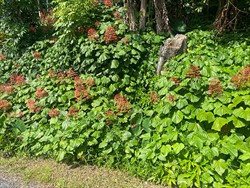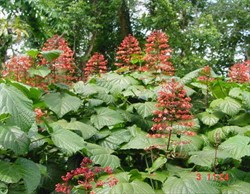- Widespread distribution. In Australia and widely among Pacific island coutries. Environmental weed. Invasive shrub of tropics and subtropics, escaping cultivation and developing thickets due to prolific suckering in disturbed areas, along roadsides, at forest margins and in open forests.
- Erect shrub up to 2 m, 4-angled stems. Leaves, large, opposite, heart-shaped with pointed tips. Flowers in a pyramid-shaped cluster, terminal or from leaf axils, petals form red/orange tube (corolla) with paler lobes. Very long male and female parts. Fruits rarely seen.
- Spread: root suckers. Long distance in domestic and international plant trade.
- Biosecurity: high risk. Readily available on Internet.
- Biocontrol: none.
- Cultural control: hand-pulling; collect stem pieces and burn. Repeated applications necessary.
- Chemical control: In FSM, triclopyr or glyphosate. Leaf spray or cut stump/paint treatments (see Fact Sheet no. 546).







